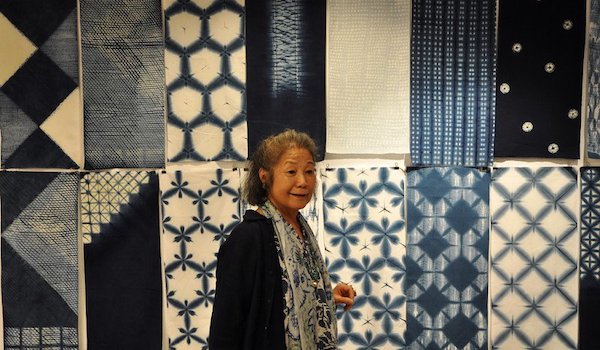
True Blue

Yoshiko Wada is a highly influential artist and scholar who is known world-wide as an authority on Japanese shibori. Yoshiko is president of the World Shibori Network and travels the world teaching and lecturing on historical and contemporary textiles. Selvedge caught up with Yoshiko to talk about Mexico, shibori and sustainability.
Selvedge: In 2016 you co-chaired the International Shibori Symposium in Mexico. What drew you there?
YW: The strongest impetus for organising the symposium in Mexico came from finding a local shibori-related tradition. This was seen in a tie-and-stitch resist dyed woollen skirt, recorded as being made in 1957 in Querretaro. I also learned about historical references to related dying methods in a codex of tie-resist patterned textile. The two or three primary colour dyes, of red, yellow, blue that were used in tie-dye (amarras) Pre-Columbian textiles were from cochineal, fustic, and indigo. These dyes led me to make a film with Michel Garcia, the second I had made with him. I filmed natural dye workshops in Oaxaca, paying homage to a perfect red dye, a cochineal which the Spanish had taken advantage of as a trade commodity. The jaspe ikat tradition of compression resist dyeing is wonderful and it resonated with Japanese cotton kasuri tradition, so I asked Carla Fernandez to collaborate with a Kurume kasuri business in Kyushu to create a fashion piece using jaspe and kasuri fabrics.
The 9th International Shibori Symposium in 2014 was held at the China National Silk Museum in Hangzhou. The theme that year was ‘Resist-Dyeing from Silk Road’. I had decided to include ikat, as I was inspired by the Xinjian's Uighur ikat weavings which are very similar to that of Uzbekistan. Dimensional transformation is an important aspect of shibori, and it is also part of the compression resist dyeing process of ikat. Within the ikat process, the yarn or thread (one-dimensional) becomes a bunch of yarns (three-dimensional) which are woven after the patterns are resist dyed and made into fabric (two-dimensional).
Selvedge: Do you think that the perception of traditional craft is changing now that we are seeing more interest in sustainability and repair?
YW: I don't think people's perception of traditional crafts are changing (they don't have much opinion about it), but I see in the younger generation a lack of understanding of materials and how the hand and body interact with them. There is definitely a disconnect between what people consume and their knowledge of how these products were made or where they come from. This lack of regards to materials and making of things leads to wasteful, unconscious consumerism in the general public. Of course, the technological advances that have crept into every day living, particularly easy online shopping, accelerates this ‘shop and throw away’ cycle. In the USA are often kept for less than two months. Yes, some people are concerned about the pollution caused by being wasteful, and perhaps a boro textile reminds them of the limited resources that people used to live with. Hopefully that sense of handwork, and the selfless stitch and patch work that went in to mending the textile touches their heart. I am also interested in promoting sustainable natural dyeing practice. This is the reason why Michel Garcia and I continue to produce films on the subject. I want to educate people, so that they know using natural dye is not necessarily sustainable.
